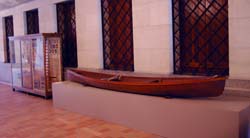The Creole State: An Exhibition of Louisiana Folklife
The Creole State Exhibit is a virtual exhibit featuring the Creole State Collection which has more than 200 artifacts in seven sections. The entire collection is presented in this virtual exhibit. For the virtual exhibit, use the links below. Some artifacts are on display in the Louisiana State Capitol while others can be seen in the Louisiana State Museum in Baton Rouge.
The Creole State Exhibit in the Louisiana State Capitol is provided by Lt. Governor Jay Dardenne and the Department of Culture, Recreation and Tourism. It is located in Ackal Hall on the ground floor.
An education guide is available for educators to use during field trips to the State Capitol.
View the Exhibit
Select a section below for more information.
You may also browse by selecting "View All Artifacts"
or search all of the exhibit artifacts using the form.
Cultural Conservation Folk Toys
Ritual, Festival & Religion Domestic Crafts Decorative Folk Arts
Occupational Crafts Folk Instruments
Many of the Creole State Exhibit artifacts were photographed
by Thomas A. Wintz, Jr.
Introduction
Louisiana is among the most culturally diverse states in the country. This exhibit presents the cultural creations of traditional life found in the state today. Nearly all of the items displayed are made or used by living individuals who carry on traditional performances, arts, crafts, beliefs, or languages learned informally as part of ethnic, regional, occupational or familial life. The objects represent the persistence of folklife on the Louisiana landscape.

Predominantly Catholic southern Louisiana has been described as "South of the South" due to the Mediterranean-African roots and plantation past of the region that make it and New Orleans more akin to the societies of the French and Spanish West Indies than of the American South. Cajun culture, derived from the late eighteenth-century of Acadians from Nova Scotia dominates much of the rural areas. However, there is also a complex mix of Afro-French, Spanish, Native American, German, Italian, Irish, Anglo, Isleño, Slavonian, and now Asian among other groups in the entire region.
In contrast, Protestant northern Louisiana is culturally part of the upland and riverine American South. North Louisiana's mainly rural folk landscape was shaped by contact between Indians, Anglo- and Afro-Americans in pioneer, plantation, sharecropping and farmstead settings among the river bottom lands, piney woods and hills of the area. In this relatively isolated and more Anglo-influenced part of the state, the cultural groups are less overlapped than in South Louisiana.
To account for the subtlety and complexity of Louisiana's cultural mix and regional differences, it has sometimes been called "the Creole State." It is appropriate to Louisiana and this exhibit that the term "creole" (from the Portuguese crioulo "native to a region") has many hues of meaning. Initially, in Louisiana, the West Indies and Latin America, "Creole" referred to the colonial French/Spanish population. The word later came to refer to the gens libres de couleur (free people of color) in Louisiana who were of mixed Afro-European descent. It is further used to describe the Afro-French language called Creole and a variety of foodways, music styles, architecture, and attitudes that reflect the mingling of cultures in Louisiana. At the broadest level, creole or creolization refers to the process where foreign ingredients are combined in a native setting to make a new creole culture. Thus the many cultures that have come to all of Louisiana, north and south, make up a "creole society."
The process of creolization in Louisiana has already produced jazz, zydeco, Creole food, Cajun music, rockabilly music and durable crafts traditions. Although the term "creole" was not originally part of North Louisiana's regional culture, that area has always mingled politically, socially, and culturally with South Louisiana while maintaining a sense of its difference. This virtual exhibit invites you to experience both the unity and diversity of folklife from The Creole State.



